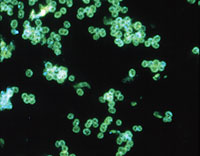Fluoroquinolone-resistant gonorrhea increased significantly since 2001
Gonorrhea is the second most common STD; the highest rates are reported among teens, young adults and blacks.
Click Here to Manage Email Alerts
Neisseria gonorrhoeae is resistant to fluoroquinolones and physicians should treat it using only cephalosporins.
Drug-resistant N. gonorrhoeae is widespread among both heterosexuals and men who have sex with men (MSM), according to the CDC, which documented 339,598 cases of gonorrhea in 2005. In 2006, 8.6% of isolates collected in the United States were resistant to fluoroquinolones. The CDC changes treatment recommendations when more than 5% of isolates are resistant in defined groups and locations.
The Morbidity and Mortality Weekly Report published the CDC’s treatment recommendations. The gonorrhea recommendations update last year’s CDC guidelines, “Sexually Transmitted Diseases: Treatment Guidelines, 2006.”
Nonsusceptibility rates
Physicians have commonly prescribed fluoroquinolones since 1993 due to their convenience as one-dose therapy, and their availability and high efficacy. In 2000, the recommendations no longer included fluoroquinolones for N. gonorrhoeae infection in Asia or the Pacific Islands, including Hawaii, due to increasing resistance rates. In 2002, the recommendation against fluoroquinolones extended to California. In 2004, the recommendations were modified further when the CDC recommended that fluoroquinolones not be used to treat infection in MSM.
The CDC based the newest recommendations on data from the Gonococcal Isolate Surveillance Project (GISP), which has monitored susceptible N. gonorrhoeae since 1986 by collecting 6,000 urethral gonococcal isolates from men aged 26 to 30 receiving treatment from STD clinics. Twenty-five of the 26 GISP sites identified fluoroquinolone-resistant N. gonorrhoeae during January 2006 to June 2006.
The researchers found that less than 1% of isolates were resistant to ciprofloxacin from 1990 to 2001, but increased during the following years. In 2002, 2.2% of isolates were resistant to ciprofloxacin; in 2003, 4.1% were resistant; and in 2004, 6.8% were resistant. Of the 6,199 isolates collected in 2005, 9.5% were resistant. The researchers also analyzed 3,005 isolates collected from January 2006 to June 2006; they found that 13.3% of the isolates were resistant.

When the researchers excluded data from California and Hawaii, they found that 6.1% of isolates were resistant in 2000 and 8.6% were resistant in 2002. However, intermediate resistance to ciprofloxacin remained stable from 1990 to 2006, and ranged from 0.4% to 1.1%.
Resistance increased at a slower rate among heterosexual males compared with MSM. In 2001, 1.6% of isolates obtained among MSM were resistant, compared with 0.6% among heterosexual men. These rates increased to 7.2% among MSM and 0.9% among heterosexual men in 2002. Preliminary 2006 data gathered from January to June suggest that resistant isolates increased to 38.3% among MSM and 3.8% among heterosexual men.
Some cities found substantial increases in resistant N. gonorrhoeae. In 2004, 4.6% of isolates collected in Seattle were resistant, compared with 19.2% in 2006. In Philadelphia, 1.2% of isolates were resistant in 2002, compared with 26.6% in 2006.
Treatment recommendations
The CDC recommends a single dose of 125 mg of ceftriaxone (Rocephine, Roche Pharmaceuticals), administered intramuscularly, or a single oral dose of 400 mg of cefixime (Suprax, Lupin Pharmaceuticals) for uncomplicated urogenital and anorectal gonorrhea infections. Cefixime is only available in a suspension formulation.
Alternative single-dose regimens for urogenital and anorectal gonorrhea include 500 mg of ceftizoxime (Cefizox, Astellas), 500 mg of cefotaxime (Claforan, Aventis), or 2 g of cefoxitin (Mefoxin, Merck) with 1 g probenecid (Col-Probenecid, Danbury Pharmacal), although alternative treatment methods are not more effective than ceftriaxone, according to the CDC.
Patients who are allergic to penicillin or cephalosporins may receive a single, intramuscular dose of 2 g of spectinomycin, which is not available in the United States.
The CDC recommends a single intramuscular dose of 125 mg of ceftriaxone for pharyngeal gonorrhea. Cefixime, cefpodoxime (Vantin, Pfizer), cefuroxime and spectinomycin (Trobicin, Pharmacia and Upjohn Company) do not appear to adequately treat pharyngeal gonorrhea.
Although a single dose of 2 g of azithromycin is effective against uncomplicated gonococcal infections, the CDC does not recommend widespread use because of the emergence of azithromycin-resistant isolates in the United States and other countries. Azithromycin may be administered in patients with severe penicillin or cephalosporin allergies. In addition, patients with a possible Chlamydia trachomatis coinfection should also receive azithromycin or doxycycline, according to the CDC.
The CDC encourages state and local health departments to maintain or develop a capacity to culture N. gonorrhoeae and remain vigilant for emergence of cephalosporin-resistant N. gonorrhoeae. – by Lauren Riley
For more information:
- CDC. Update to CDC’s sexually transmitted diseases treatment guidelines, 2006: Fluoroquinolones no longer recommended for treatment of gonococcal infections. MMWR. 2007;56:332-336.
- Visit the CDC’s website for information about the availability of cefixime and spectinomycin at www.cdc.gov/std/gonorrhea.
